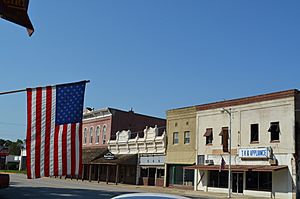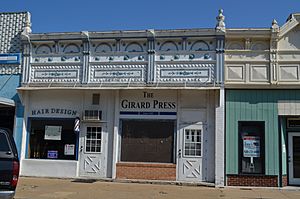Girard, Kansas facts for kids
Quick facts for kids
Girard, Kansas
|
|
|---|---|
|
City and County seat
|
|
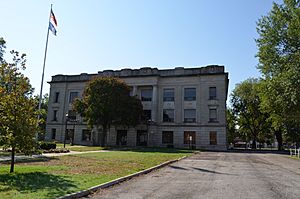
Crawford County Courthouse (2012)
|
|
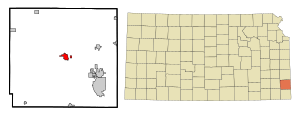
Location within Crawford County and Kansas
|
|
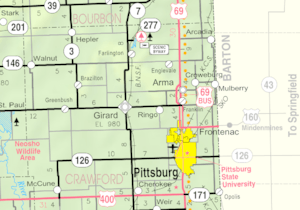
|
|
| Country | United States |
| State | Kansas |
| County | Crawford |
| Founded | 1868 |
| Incorporated | 1869 |
| Named for | Girard, Pennsylvania |
| Area | |
| • Total | 2.37 sq mi (6.14 km2) |
| • Land | 2.33 sq mi (6.05 km2) |
| • Water | 0.04 sq mi (0.10 km2) |
| Elevation | 991 ft (302 m) |
| Population
(2020)
|
|
| • Total | 2,496 |
| • Density | 1,053.2/sq mi (406.5/km2) |
| Time zone | UTC-6 (CST) |
| • Summer (DST) | UTC-5 (CDT) |
| ZIP code |
66743
|
| Area code | 620 |
| FIPS code | 20-26300 |
| GNIS ID | 485582 |
Girard is a city in Crawford County, Kansas, United States. It is also the county seat, which means it's where the main government offices for the county are located. In 2020, about 2,496 people lived in Girard.
Contents
History of Girard
Girard was started in the spring of 1868. It was named after Girard, Pennsylvania, where one of its founders, Charles Strong, used to live. The city was planned along the route of a new railroad line. This helped it grow faster than a nearby town called Crawfordsville.
The first post office in Girard opened in September 1868. The city had its first big celebration on July 4, 1868, for Independence Day. In 1871, Girard officially became a city, and its first city leaders were chosen.
Early Businesses
- Banks: The first bank in Girard was started by Franklin Playter in June 1871. He built the city's first brick building for his bank in 1872. Over the years, this bank changed names a few times, becoming the Bank of Girard and then the Girard Bank.
- Mills: The Girard Mills were built in 1870 and started working in 1871. They processed grain into flour. Another mill, the Crawford County Mills, was also built in 1870. These mills helped the local farmers and economy.
Mining in the Area
The area around Girard had a lot of coal. The first mining camps were along Carbon Creek. Miners dug coal from strip pits, which are open areas where coal is close to the surface. By 1877, about 100 miners were working there.
Many mines closed in the 1960s. Today, you can see old strip mines filled with water, which are now used for fishing and as homes for wildlife. There are also ruins of old factories that processed zinc and lead. Some of these areas are called Superfund sites, meaning they need special cleaning because of leftover pollution from the factories. Today, farming is the main industry in the county.
Immigration and Culture
As the mining industry grew, many immigrants came to Crawford County to work in the mines. These new residents often came from Southern Europe and the Balkans. They brought new cultures and traditions, including the Catholicism religion, which was different from most people already living there.
To attract more miners, the city advertised in Europe, promising good jobs in Kansas. Steamship companies even helped workers travel to America. From 1880 to 1915, many people from over fifty different countries came to work in the coal mines and factories. Today, Crawford County celebrates this diverse history with an event called "Little Balkan Days."
Socialism in Girard
In the early 1900s, Girard became a center for socialist ideas. A newspaper called Appeal to Reason moved to Girard in 1896. It became very popular and shared socialist views.
- Upton Sinclair and The Jungle: In 1904, the newspaper asked writer Upton Sinclair to write a book about immigrant workers in meat factories. Sinclair wrote The Jungle, which showed the harsh conditions. The book was published in 1906 and helped make the newspaper even more popular. It also led to new laws about food safety. The Appeal to Reason newspaper printed hundreds of thousands of copies each week and published many other socialist books.
- Eugene V. Debs: Eugene V. Debs, a famous socialist leader, lived in Girard and worked for the Appeal to Reason. He ran for President of the United States five times. In 1912, he received many votes, even winning Crawford County. During World War I, Debs was put in prison for speaking out against the war. He even ran for president from prison in 1920.
- Little Blue Books: In 1915, Emanuel Julius came to Girard to write for the Appeal to Reason. He later started printing small, affordable paperback books called Little Blue Books. His goal was to make good books available to everyone at a low price. He became known as "the Henry Ford of literature" because he made books so widely available. The printing plant in Girard continued to print these books until it was destroyed by fire in 1978.
Tornadoes
In May 2003, a very powerful tornado hit Crawford County. It killed four people and injured many more in the area. The tornado was very wide and traveled near Girard, causing a lot of damage.
Geography of Girard
Girard is located on a flat, gently rolling prairie in the middle of Crawford County. The city is laid out in a grid pattern, with a public square in the center.
The city covers about 2.44 square miles (6.32 square kilometers). Most of this area is land, with a small amount of water.
Climate
Girard has a climate with hot, humid summers and generally mild to cool winters. This type of climate is called a humid subtropical climate.
| Climate data for Girard, Kansas (1991–2020 normals, extremes 1957–present) | |||||||||||||
|---|---|---|---|---|---|---|---|---|---|---|---|---|---|
| Month | Jan | Feb | Mar | Apr | May | Jun | Jul | Aug | Sep | Oct | Nov | Dec | Year |
| Record high °F (°C) | 74 (23) |
83 (28) |
89 (32) |
97 (36) |
96 (36) |
103 (39) |
110 (43) |
107 (42) |
106 (41) |
94 (34) |
84 (29) |
77 (25) |
110 (43) |
| Mean maximum °F (°C) | 65.4 (18.6) |
70.1 (21.2) |
78.7 (25.9) |
83.2 (28.4) |
88.7 (31.5) |
94.2 (34.6) |
98.8 (37.1) |
99.5 (37.5) |
93.8 (34.3) |
85.5 (29.7) |
74.6 (23.7) |
66.5 (19.2) |
100.2 (37.9) |
| Mean daily maximum °F (°C) | 41.6 (5.3) |
46.9 (8.3) |
57.3 (14.1) |
67.0 (19.4) |
75.9 (24.4) |
85.2 (29.6) |
89.8 (32.1) |
89.2 (31.8) |
81.0 (27.2) |
69.3 (20.7) |
56.1 (13.4) |
45.1 (7.3) |
67.0 (19.4) |
| Daily mean °F (°C) | 32.0 (0.0) |
36.6 (2.6) |
46.4 (8.0) |
56.1 (13.4) |
65.8 (18.8) |
75.2 (24.0) |
79.6 (26.4) |
78.3 (25.7) |
69.9 (21.1) |
58.1 (14.5) |
45.8 (7.7) |
35.8 (2.1) |
56.6 (13.7) |
| Mean daily minimum °F (°C) | 22.3 (−5.4) |
26.2 (−3.2) |
35.5 (1.9) |
45.2 (7.3) |
55.8 (13.2) |
65.2 (18.4) |
69.4 (20.8) |
67.5 (19.7) |
58.8 (14.9) |
46.9 (8.3) |
35.4 (1.9) |
26.5 (−3.1) |
46.2 (7.9) |
| Mean minimum °F (°C) | 5.5 (−14.7) |
10.9 (−11.7) |
18.1 (−7.7) |
30.9 (−0.6) |
42.3 (5.7) |
54.9 (12.7) |
61.4 (16.3) |
58.7 (14.8) |
45.3 (7.4) |
31.9 (−0.1) |
19.9 (−6.7) |
10.0 (−12.2) |
1.5 (−16.9) |
| Record low °F (°C) | −12 (−24) |
−16 (−27) |
−6 (−21) |
20 (−7) |
32 (0) |
45 (7) |
51 (11) |
48 (9) |
32 (0) |
19 (−7) |
5 (−15) |
−18 (−28) |
−18 (−28) |
| Average precipitation inches (mm) | 1.77 (45) |
1.90 (48) |
3.48 (88) |
4.83 (123) |
6.45 (164) |
5.43 (138) |
3.93 (100) |
3.88 (99) |
4.84 (123) |
3.76 (96) |
3.03 (77) |
2.31 (59) |
45.61 (1,158) |
| Average snowfall inches (cm) | 2.6 (6.6) |
0.4 (1.0) |
0.9 (2.3) |
0.0 (0.0) |
0.0 (0.0) |
0.0 (0.0) |
0.0 (0.0) |
0.0 (0.0) |
0.0 (0.0) |
0.0 (0.0) |
0.7 (1.8) |
1.6 (4.1) |
6.2 (16) |
| Average precipitation days (≥ 0.01 in) | 6.0 | 6.1 | 9.2 | 9.9 | 11.3 | 9.6 | 8.0 | 7.6 | 6.8 | 8.4 | 6.1 | 6.3 | 95.3 |
| Average snowy days (≥ 0.1 in) | 1.1 | 0.4 | 0.3 | 0.0 | 0.0 | 0.0 | 0.0 | 0.0 | 0.0 | 0.0 | 0.2 | 0.7 | 2.7 |
| Source: NOAA | |||||||||||||
Population of Girard
| Historical population | |||
|---|---|---|---|
| Census | Pop. | %± | |
| 1880 | 1,289 | — | |
| 1890 | 2,541 | 97.1% | |
| 1900 | 2,473 | −2.7% | |
| 1910 | 2,446 | −1.1% | |
| 1920 | 3,161 | 29.2% | |
| 1930 | 2,442 | −22.7% | |
| 1940 | 2,554 | 4.6% | |
| 1950 | 2,426 | −5.0% | |
| 1960 | 2,350 | −3.1% | |
| 1970 | 2,591 | 10.3% | |
| 1980 | 2,888 | 11.5% | |
| 1990 | 2,794 | −3.3% | |
| 2000 | 2,773 | −0.8% | |
| 2010 | 2,789 | 0.6% | |
| 2020 | 2,496 | −10.5% | |
| U.S. Decennial Census | |||
2020 Census Data
In 2020, the 2020 United States census counted 2,496 people living in Girard. There were 1,008 households, and 661 families. The population density was about 1,069 people per square mile.
Most of the people (about 89%) were white. There were also people who identified as black, Native American, Asian, or from two or more races. About 2.6% of the population was Hispanic or Latino.
About 26.6% of the people were under 18 years old. The average age in the city was 40.4 years.
2010 Census Data
In 2010, the census showed that 2,789 people lived in Girard. There were 1,080 households. The population density was about 1,162 people per square mile.
About 94.4% of the people were white. Other groups included African American, Native American, and Asian. About 2.7% of the population was Hispanic or Latino.
About 24.9% of residents were under 18 years old. The average age in the city was 39 years.
Education in Girard
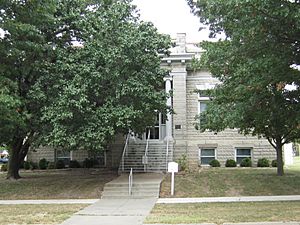
Girard has its own public school district, Girard USD 248.
Public Schools
- Girard High School
- Girard Middle School
- R.V. Haderlein Elementary School
Public Library
Media and News
Newspapers
The Girard Press newspaper started in Girard in November 1869. In 1871, the newspaper's office was burned down, but they quickly got new equipment and started publishing again.
The Girard Press stopped publishing in September 2008. A new newspaper, Hometown Girard, began in February 2013. It is published every two weeks.
Notable People
Girard has been home to several notable people:
- Edythe Baker, a jazz pianist
- Percy Daniels, who was the lieutenant governor of Kansas from 1892-94
- Dennis Franchione, a college football coach
- Thomas Everhart, a former president of California Institute of Technology
- Jane Grant, a journalist who helped start The New Yorker magazine
- Dennis Hayden, an actor and producer
- Charles Holland, a city council member in Los Angeles, California
- Eugenio Kincaid, a Baptist missionary
- Ron Kramer, a football player
- Ruth Stout, an author
- Julius Wayland, a socialist writer and publisher
Images for kids
See also
 In Spanish: Girard (Kansas) para niños
In Spanish: Girard (Kansas) para niños


